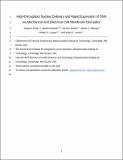High-throughput nuclear delivery and rapid expression of DNA via mechanical and electrical cell-membrane disruption
Author(s)
Ding, Xiaoyun Sean; Stewart, Martin P; Sharei, Armon Reza; Weaver, James C; Langer, Robert S; Jensen, Klavs F; ... Show more Show less
DownloadDFE manuscript main text.pdf (248.5Kb)
PUBLISHER_POLICY
Publisher Policy
Article is made available in accordance with the publisher's policy and may be subject to US copyright law. Please refer to the publisher's site for terms of use.
Terms of use
Metadata
Show full item recordAbstract
Nuclear transfection of DNA into mammalian cells is challenging yet critical for many biological and medical studies. Here, by combining cell squeezing and electric-field-driven transport in a device that integrates microfluidic channels with constrictions and microelectrodes, we demonstrate nuclear delivery of plasmid DNA within 1 h after treatment—the most rapid DNA expression in a high-throughput setting (up to millions of cells per minute per device). Passing cells at high speed through microfluidic constrictions smaller than the cell diameter mechanically disrupts the cell membrane, allowing a subsequent electric field to further disrupt the nuclear envelope and drive DNA molecules into the cytoplasm and nucleus. By tracking the localization of the endosomal sorting complex required for transport III protein CHMP4B (charged multivesicular body protein 4B), we show that the integrity of the nuclear envelope is recovered within 15 minutes of treatment. We also provide insight into subcellular delivery by comparing the performance of the disruption-and-field-enhanced method with those of conventional chemical, electroporation and manual-injection systems.
Date issued
2017-03Department
Harvard University--MIT Division of Health Sciences and Technology; Massachusetts Institute of Technology. Department of Chemical Engineering; Koch Institute for Integrative Cancer Research at MITJournal
Nature Biomedical Engineering
Citation
Ding, Xiaoyun, et al. “High-Throughput Nuclear Delivery and Rapid Expression of DNA via Mechanical and Electrical Cell-Membrane Disruption.” Nature Biomedical Engineering 1, 3 (March 2017): 0039 © 2017 Macmillan Publishers Limited, part of Springer Nature
Version: Author's final manuscript
ISSN
2157-846X